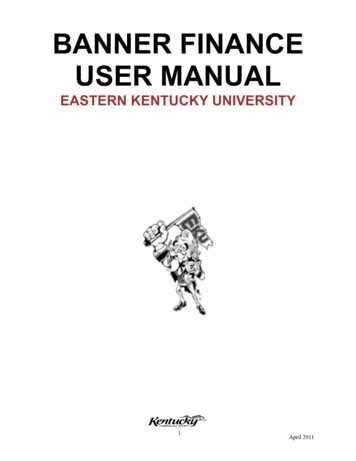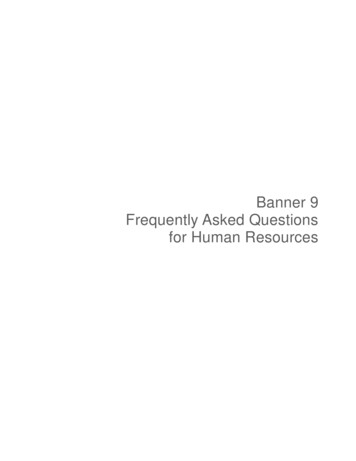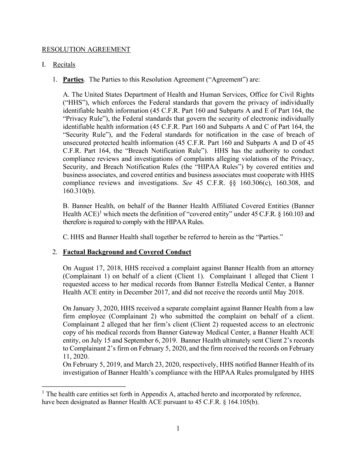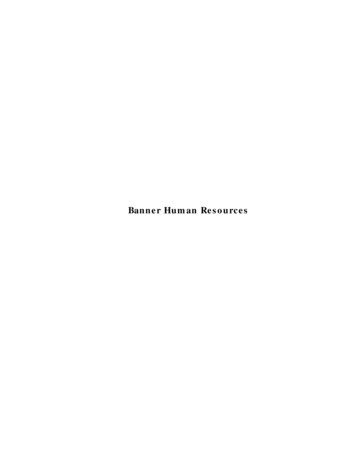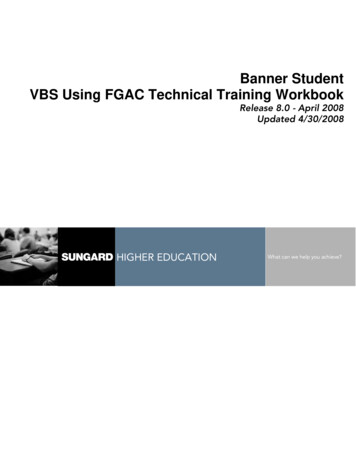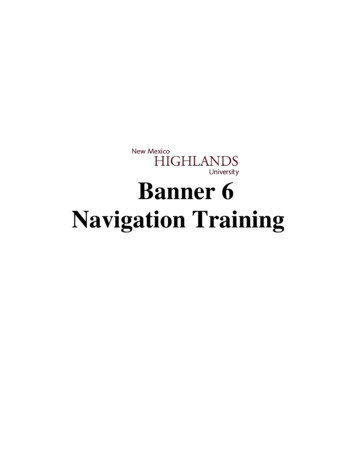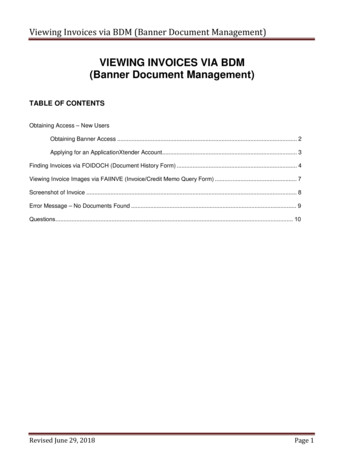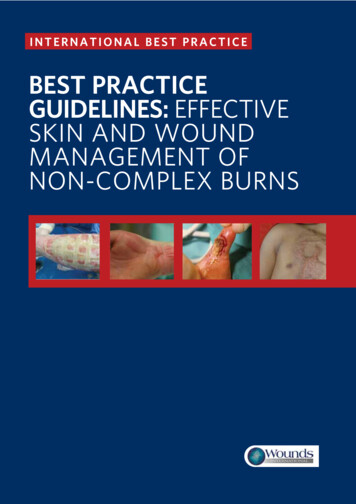Transcription
The Beacon – August 2020 Review A Review of August 2020Banner County Fire Burnsthrough Wildcat HillsSouth of Gering, Aug. 27.Nebraska Emergency Management AgencyPage 1
The Beacon – August 2020 ReviewA Message fromNEMA Assistant DirectorBryan TumaWe envision safer, less vulnerable communities in Nebraska made possible through effective collaborativepartnerships committed to saving lives and reducingthe impact of disasters.Our mission is to coordinate, support and serve Nebraska through an effective and relevant emergencymanagement agency.What a difference a year makes. At this time last year, we were all extremely busy recovering from one of thestate’s largest disasters, the spring 2019 floods. Now, drought conditions are affecting more than half the state andwe are faced with wildfires. It’s why we train for anall-hazards response.We have been busy monitoring the increasingly dry conditions statewide, and, with those conditions, the increased risk for wildfire activity this summer. A number of wildfires have already occurred including the 4,000 acrefire in Banner County last week. The Hubbard Gap Fire in the Wildcat Hills south of McGrew illustrates how important it is for us to monitor drought conditions and to prepare for wildfires.Emergency management and firefighters in the western portion of Nebraska have been proactive in their approach to getting ready to battle wildfires. The yearly Western Engine Academy provides a great opportunity to worktogether on wildfire response and it was evident in the coordinated effort on the Hubbard Gap Fire.The rapid response of the local volunteer fire agencies and their capacity to effectively organize a response tothis fire should be commended. State agency partners worked with Region 22 Emergency Management and theincident commander to identify resources needed to fight this fire. Significant investment in training and planninghave paid dividends in forming an effective response to this event.It takes a team effort to fight a fire of this size and Nebraska’s response was just that. In addition to the localfirefighters and emergency management efforts, the State Fire Marshal’s Wildland Incident Response AssistanceTeam, the Nebraska Forest Service single engine air tanker team, NEMA and air support from South Dakota and theNebraska Army National Guard all worked together to put this fire to rest.That joint effort in preparedness is what’s required when these fires get out of hand.Sincerely,Bryan TumaNebraska Emergency Management AgencyPage 2
The Beacon – August 2020 ReviewSeptember is National Preparedness MonthNational Preparedness Month (NPM) is recognized each Septemberto promote family and community disaster planning now and throughout the year. As our nation continues to respond to COVID-19, there isno better time to be involved this September. The 2020 NPM theme is:Disasters Don’t Wait. Make Your Plan Today.Check out the 2020 National Preparedness Month Toolkit for tips and ideasto promote preparedness all month long.Make a plan today. Your family may not be together if a disaster strikes, soit is important to know which types of disasters could affect your area. Knowhow you’ll contact one another and reconnect if separated. Establish a familymeeting place that’s familiar and easy to find. Step 1: Discuss your plan with family, friends and household members. Step 2: Consider specific needs in your household. Step 3: Fill out a Family Emergency Plan Step 4: Practice your plan with your family/householdBuild A Kit. After an emergency, you may need to survive on your own forseveral days. Being prepared means having your own food, water and othersupplies to last for several days. A disaster supplies kit is a collection of basicitems your household may need in the event of an emergency.Consider adding the following items to your emergency supply kit based onyour individual needs: Cloth face coverings (for everyone ages 2 and above), soap, hand sanitizer, disinfecting wipes to disinfect surfaces Prescription medications Non-prescription medications such as pain relievers, anti-diarrhea medication, antacids or laxatives Prescription eyeglasses and contact lens solution Infant formula, bottles, diapers, wipes and diaper rash cream Pet food and extra water for your pet Cash or traveler’s checks Important family documents such as copies of insurance policies, identification and bank account records saved electronically or in a waterproof, portable container Sleeping bag or warm blanket for each person Complete change of clothing appropriate for your climate and sturdyshoes Fire extinguisher Matches in a waterproof container Feminine supplies and personal hygiene items Mess kits, paper cups, plates, paper towels and plastic utensils Paper and pencil Books, games, puzzles or other activities for childrenPrepare for Disasters Know what disasters and hazards could affect yourarea, how to get emergency alerts, and where you would go if you and yourfamily need to evacuate. Make sure your family has a plan and practices itoften.Teach Youth about Preparedness Disasters happen everywhere, and everymember of the family can prepare. Preparedness for the future starts today.Whether you’re a kid or teen yourself, a parent or loved one, or work withyouth, Ready Kids has tools and information to help before, during and afterdisasters.Nebraska Emergency Management AgencyWeek 1 Sept. 1-5: Make A PlanTalk to your friends and family about how you will communicate before, during, and aftera disaster. Make sure to updateyour plan based on the Centersfor Disease Control recommendations due to the coronavirus.Week 2 Sept. 6-12: Build A KitGather supplies that will lastfor several days after a disaster for everyone living in yourhome. Don’t forget to considerthe unique needs each person or pet may have in caseyou have to evacuate quickly.Update your kits and suppliesbased on recommendations bythe Centers for Disease Control.Week 3 Sept. 13-19: Preparefor DisastersLimit the impacts that disasters have on you and yourfamily. Know the risk of disasters in your area and check yourinsurance coverage. Learn howto make your home stronger inthe face of storms and othercommon hazards and act fastif you receive a local warning oralert.Week 4 Sept. 20-26: TeachYouth About PreparednessTalk to your kids aboutpreparing for emergencies andwhat to do in case you are separated. Reassure them by providing information about how theycan get involved.Page 3
FAQsThe Beacon – August 2020 ReviewState of NebraskaNOTE: This document addressesthe issue of presumptive costs forPublic Safety payroll issues only. Allother issues addressed in the previous guidance provided July 2, 2020remain in effect.Are fringe benefits, comp time,vacation, etc. going to be eligibleunder CRF in Nebraska?These costs are not eligible forreimbursement under the CRF program and should not be includedin your CRF claim for public safetycosts. However, some benefit costsmay be eligible for any overtimeclaimed under FEMA public assistance (PA).Can overtime costs not eligiblefor PA be claimed under CRF?No, overtime costs will be eligibleunder the CRF program and shouldnot be included in your CRF claimfor public safety costs. However,costs directly related to COVID -19activities may be claimed underFEMA PA.Is payroll for quarantined officers (while in quarantine) eligibleunder CRF updated guidance?No, costs for public safety officials while in quarantine are noteligible under the CRF program.Are the local governments beingreimbursed on a first come, firstserve basis?No, reimbursements are not determined on a first come, first servebasis. As of Aug. 20, the governorhas increased the local government program funding from 100million to 130 million in anticipation of the costs expected for thisUpdated: August 20, 2020Frequently Asked QuestionsFor Local Government Requests for Reimbursement forCOVID-19 Related ExpensesSupplemental Guidance for Reimbursement of PublicSafety Costs through the Coronavirus Relief Fund (CRF).program. Please note, claims andreimbursements will be monitoredon an ongoing basis to determinepotential future needs and fundingoptions.Reimbursement must be requested no later than Sept. 15 – anyrequests made after this date willnot be accepted or considered.Requests for additional eligibleemployees outside of current definition: Community service officers(non-sworn) 911 call center and other COVID-19 trainees Certified dispatchersNo, these employees are not eligible for reimbursement under thisprogram. Eligible employees will berestricted to those identified in theguidance released by the state:For the purposes of this reimbursement program, a public safetyemployee is an employee of acounty, city, municipality or villagein the state whose principal dutiesinclude services requiring specialized training in the area of policeprotection, firefighting services, oremergency medical services for anyarea within the jurisdiction of theidentified eligible applicants.Examples of full-time employeeswhose presumptive payroll costmay be reimbursed include:sheriff, deputy sheriff, police chief,police captain, police lieutenant,police officer, police sergeant, firechief, fire engineer, fire captain,firefighter and emergency medicalservice personnel.Nebraska Emergency Management AgencyHow do I request reimbursementfor my eligible costs under thisprogram?The first step is to request usercredentials to the reimbursementportal via this link. Once you havereceived credentials, log into theportal via the link provided in yourapproval email and select “createrequest for reimbursement.” Complete the form, attach all supportingdocumentation, and submit yourrequest for review.What documentation is requiredfor my request for reimbursementunder this program?Cost incurred is verified by reviewing documentation that reflectshourly/salaried wages, benefitsrates, hours worked, and proof ofpayment. Only the summary pageof the payroll register reflecting thetransaction total is needed – notthe entire payroll register for employees unrelated to the claim.For CRF payroll reimbursementclaims for public safety officialsas defined by the state’s guidance,please provide the following supporting documentation: Applicant payroll and benefitspolicy Labor claim summary (templateprovided by state) Pre-disaster paystub Approved timesheets Approved activity logs for applicants/employees that do notuse timesheets Payroll register summary forpay period claims Pay stubs for pay period claims Bank statement for pay periodclaimedPage 4
The Beacon – August 2020 ReviewPartnerUpdatesDepartment of AgricultureThe Nebraska Department of Agriculture (NDA) in partnership with the U.S. Departmentof Agriculture (USDA), confirmed emerald ash borer (EAB) in a trap in Seward county anda tree in Washington county. This is the first detection of EAB in both counties. EAB, aninvasive beetle that attacks and kills ash trees, was first found in Omaha in 2016 and themost recent discovery was earlier this year in Kearney.U.S. Department of Agriculture’s (USDA)The USDA Food Safety and Inspection Service (FSIS) is reminding the public to think about health and safety in thekitchen for National Food Safety Education Month this September. Consumers are encouraged to practice behaviors thatwill continue to help keep them and their loved ones safe from foodborne illness.Nebraska State Office USDA Farm Service AgencyThe USDA announced several important pieces of information related to the Coronavirus Food Assistance Program(CFAP). The deadline to apply for assistance through this program was extended and is now set for Sept. 11. This program provides direct relief to producers who faced price declines and additional marketing costs due to COVID-19. Producers with already-completed CFAP applications should have received the remaining 20 percent of their payment; FSAissued producers 80 percent of their estimated overall CFAP payment initially, holding back 20 percent in order to assurefunding for all eligible applicants. Going forward, new CFAP applicants will receive the full payment benefit, up to the payment limitation, once their application is approved. FSA also announced the addition of several commodities into CFAP,including some that would be applicable to Nebraska, such as sheep over 2 years of age, nursery crops, aquaculture andsome specific types of eggs (liquified and frozen). As of Aug. 17, Nebraska FSA has issued 650 million in CFAP assistance, with about 60 percent of that going to livestock, about 39 percent to crops, and 1.6 percent to dairy.Nebraska Department of TransportationNDOT reported in the latest issue of its newsletter, The Roadrunner, that all highway miles are open following the 2019flood. The majority of projects resulting from the blizzard and flood of 2019 have been completed. That’s remarkablegiven that 3,300 highways miles were closed at one point, in addition to 27 bridges. Within a span of six months, onlyone highway mile remained closed, as 85 flood-related projects were underway on state highways. Total flood damageson the state highway system are estimated at 150 million. The greatest financial cost has been incurred by District 3 innortheast Nebraska, with an estimated 65 million in flood damagesDepartment of Health and Human ServicesDHHS officials issued the following statement regarding a rumor that recently surfaced on social media claiming thattest results from Test Nebraska had been misplaced: “We want to reassure people that the Test Nebraska lab has not lostor misplaced test results. Test Nebraska, however, did have a technical issue where one of the contractor’s data systemsstopped pushing results to another system, causing test results from Aug. 19-23 to not be reported to the person who wastested or into DHHS’ data collection system. Because a test was not associated with a number of people’s profiles due tothis technical issue, the call center directed people to get retested. The standard language in the email triggered by the callcenter in response to these inquiries improperly referenced lost test results. Test results from Wednesday to the presenthave now been delivered. We sincerely apologize for the delay. We take very seriously the responsibility to ensure properand timely data reporting. We have safeguards in place to address issues if and when they arise and will continue to takecorrective action as soon as they are discovered.”Nebraska State PatrolAs schools are back in session and the summer vacation season winds down, Nebraska State Troopers and officers fromdozens of other law enforcement agencies throughout Nebraska are participating in the annual Drive Sober or Get PulledOver campaign. The campaign is part of a nationwide effort to remove impaired drivers from theroad, and runs from Aug. 21 through Labor Day, Sept. 7. The operation will include troopers working overtime to enforce Nebraska’s traffic laws and monitor for impaired driving. The two-weekcampaign is made possible thanks in part to a grant for 20,000 from Nebraska Departmentof Transportation – Highway Safety Office. In 2019, approximately 25%of fatal crashes on Nebraska roads involved alcohol. The effort alsomarks the conclusion of NSP’s 100 Days of Summer initiative, whichruns from Memorial Day weekend through Labor Day weekend everyyear. Since Memorial Day weekend, troopers have arrested nearly 250motorists for driving under the influence.Nebraska Emergency Management AgencyPage 5
The Beacon – August 2020 ReviewNebraska Department of LaborThe Nebraska Department of Labor (NDOL) announced Aug. 27 that there were 2,690 newregular unemployment claims filed the week ending April 22, a decrease of 15.6 percentover the prior week when 3,189 claims were filed. There were 1,119 new Pandemic Unemployment Assistance (PUA) claims filed last week compared to 1,156 the prior week, adecrease of 3.2 percent. The highest number of new claims filed during the pandemic was26,539 claims during the week ending April 4.PartnerUpdatesCONTINUEDContinued Unemployment Claims There were 28,261 continued weeks of regular unemployment claimed the week ending April 22, a decrease over the prior week, when 30,917 claims were filed. There were23,961 continued weeks of Pandemic Unemployment Assistance (PUA) claimed last week, down slightly compared to24,355 the prior week. Continued weeks refer to the individual weeks of unemployment claimed after a person appliesfor benefits. Weekly certifications are required in order to claim continued weeks of unemployment and receive payment.Before the coronavirus pandemic, the highest number of continued weeks was in the second week of 2010 when therewere 26,075 continued weeks claimed. Of the top 50 occupations with the highest number of continued claims, 43 havedeclined by 30 percent or more since the week ending May 9, corresponding with the loosening of the direct health measures. The top continued claim occupations for the week ending Aug. 15 (the most recent week for which occupationdata is available) were cashiers (1,410), waiters and waitresses (1,168), and customer service representatives (1,168).Benefit Payments and Claim Processing NDOL paid a total of 10.5 million in benefits the week ending April 22, including regular, PUA, and Pandemic Emergency Unemployment Compensation (PEUC), which provides an additional 13 weekof benefits to individuals who have exhausted their regular benefits. Regular and PUA benefits paid each week can befound here. NDOL has paid over 129,000 individuals during the pandemic.Benefits paid since March 29: Regular UI: 270,980,474Pandemic Unemployment Assistance (gig workers/self-employed): 52,900,011Federal Pandemic Unemployment Compensation ( 600/weekly UI benefits to eligible claimants): 689,146,042Pandemic Emergency Unemployment Compensation (extends unemployment benefits by up to 13 weeks): 7,062,093Total: 1,020,422,421Nebraska Game and ParksPrescribed burns are planned in the upcoming months on some Nebraska Game and Parks Commissionwildlife management areas if weather conditions allow. Burns during the summer and fall can help setback undesirable plants that invade native prairies and other grasslands. Eastern red cedar trees andundesirable deciduous shrubs have higher mortality during summer burns because of higher air temperatures and because they’ve expended much of their energy flowering and producing fruit. Green vegetation in summer and early fall also slow the rate of a planned burn and allows it to be more predictable.Summer and fall burns, if used in conjunction with grazing, can set back smooth brome and otherinvasive plant species, increase diversity in grasslands and improve habitat for wildlife. Fewer acres areburned during summer and fall burns to be sure plenty of habitat is available going into the winter inthese immediate areas. Burns are planned for the following wildlife management areas:Northeast District – Antelope County: Grove Lake; Cedar County: Wiseman; Dakota County: Basswood;Madison County: Yellow Banks; Nance County: Council Creek; Platte County: Wilkinson; Stanton County:Red Fox, Wood DuckNorthwest District – Dawes County: Chadron Creek Ranch; Sioux County: PetersonSoutheast District – Gage County: Arrowhead; Jefferson County: Alexandria, Alexandria SW, Flathead, Rose Creek West;Johnson County: Hickory Ridge, Osage, Twin Oaks; Lancaster County: Branched Oak, Olive Creek, Wagon Train, Wildwood,Yankee Hill; Pawnee County: Bowwood, Prairie Knoll, Table Rock; Richardson County: Kinter’s Ford; Seward County: TwinLakes; Thayer County: Little Blue; York County: Marsh DuckSouthwest District – Custer County: Pressey; Frontier County: Medicine Creek, Red Willow; Hall County: Cornhusker;Hitchcock County: Swanson; Howard County: Harold Anderson, Leonard A. Koziol, Marsh Wren; Keith County: Clear Creek;Phelps County: Sacramento-Wilcox; Sherman County: Sherman ReservoirNebraska Emergency Management AgencyPage 6
The Beacon – August 2020 ReviewFederal Emergency Management Agency (FEMA)FEMA established a voluntary agreement for enhanced coordination and cooperationwith private sector manufacturers, distributors and industry representatives to providecritical health and medical resources to respond to COVID-19 and future pandemics.This five-year agreement was made under the authority of the Defense ProductionAct, Sec. 708. With this voluntary agreement, federal departments and agencies canengage with private sector partners to develop sector-specific plans of action forimproved information sharing and coordination within supply chain networks. It willbetter allow the federal government to plan for response activities with private sector partners and acquire and use real-time data to make important decisions. Participants of the agreement are granted relief from antitrust laws for specific actionstaken under the agreement. For more information on the agreement, visit the Federal Register where the agreement waspublished on Aug. 17. Companies and organizations who wish to participate in this agreement may contact ation Funding OpportunityFEMA’s Building Resilient Infrastructure and Communities (BRIC) ProgramFEMA has announced the new nationally competitive Building Resilient Infrastructure and Communities(BRIC) grant program. BRIC offers a funding opportunity for large-scale, high-impact mitigation projects as wellas state non-competitive allocation funding ( 600,000 per state) for capability and capacity building activitiesand mitigation planning. Nebraska Emergency Management Agency (NEMA)is promoting this funding opportunity during the next month and requestingthat potential applicants submit a notice of interest (NOI) to NEMA for consideration and selection to proceed with formal application submission.All project times eligible under pre-disaster mitigation (PDM) are still eligible under BRIC with the following additions: building code activities, partnerships, project scoping (formerly advanced assistance), mitigation planningand planning related activities.To seek funding, complete the NOI Form on the NEMA website and submitto the NEMA Hazard Mitigation staff via email: nema.hazardmitigation@nebraska.gov. The NEMA HM staff and the Governor’s Disaster Recovery TaskForce will review eligible NOIs and prioritize the best projects for submissionto FEMA.The NEMA HM staff will host three webinars to provide additional information on the BRIC NOFO and application instructions. The dates and links areincluded in the NOFO.FEMA has provided the following support materials to assistapplicants:Building Code ActivitiesMitigation Planning ActivitiesPartnership ActivitiesProject Scoping ActivitiesTechnical Evaluation CriteriaQualitative Evaluation CriteriaMitigation Action PortfolioThe dates and times for the Nebraska virtual applicant briefings are as follows:BRIC NOFO Webinar No. 1Sept. 3, 2 p.m. 1 hourMeeting number: 145 714 5354Password: /j.php?MTID m4513122e0661554daea70ef6c5c1a089BRIC NOFO Webinar No. 2Sept. 10, 2 pm 1 hourMeeting number: 145 241 6692Password: /j.php?MTID mf36e872cac110c480f92f6b4220bba36BRIC NOFO Webinar No. 3Sept. 17, 2 p.m. 1 hourMeeting number: 145 122 4548Password: /j.php?MTID m5938d0b3ca039221d19b4efe49949b68Nebraska Emergency Management AgencyPage 7
The Beacon – August 2020 ReviewPotential Air QualityImpacts are PossibleFrom Wildfires inWestern U.S.Numerous large wildfires in thewestern United States may affect the air quality in Nebraska.Nebraska continues to monitorsmoke levels and wind directionsand provides updates accordinglyto the media and public.Smoke advisories are issuedfor impacted areas by notifyingthe media and local health departments, and posting informationon the Nebraska Departmentof Health and Human Services(DHHS) and the Nebraska Department of Environment and Energy's(NDEE) webpages and social sites.Advisories help citizens protecttheir health by alerting them todays where outdoor activitiesshould be reduced or avoided tominimize exposure to smoke.Advisories are based on dataprovided by NDEE and the NationalWeather Service, and from airquality monitors that are locatedin Lincoln, Omaha, Bellevue, GrandIsland and Scottsbluff.The following Air Quality Index(AQI) is used. This AQI is usednationally. For an hourly update onair quality across Nebraska visithttps://www.airnow.gov.For more information on smokeawareness, visit NDEE's website athttp://deq.ne.gov/NDEQProg.nsf/OnWeb/AirSA.For more information on burnactivity and a smoke outlook,visit NDEE's website at http://deq.ne.gov/Press.nsf/pages/AirSA-2.Contact Tracing CommunicationsToolkit Helps Spread the Word AboutHow to Slow the Spread of COVID 19The Center for Disease Control and Prevention (CDC) hasreleased a COVID-19 ContactTracing Communications Toolkitfor Health Departments in aneffort to help all communicatorswork together to help slow thespread of COVID-19.Contact tracing slows thespread of COVID-19 by: Letting people know theymay have been exposed toCOVID-19 and should monitor their health for signs andsymptoms of COVID-19. Helping people who mayhave been exposed to COVID-19 get tested. Asking people to self-isolateif they have COVID-19 or selfquarantine if they are a closecontact of someone who hasCOVID-19.The toolkit is availableat act-tracing-comms.html.The bottom line: Makinga choice to help your healthdepartment in the fight againstCOVID-19 helps protect you, yourNebraska Emergency Management Agencyfamily, and your community.If you have been diagnosedwith COVID-19, a public healthworker will call you to check onyour health.They will ask you who you’vebeen in contact with and whereyou spent time while you weresick and may have spread COVID-19 to others.Any information you sharewith public health workers isCONFIDENTIAL. This meansthat your personal and medicalinformation will be kept private.You will also be asked tostay at home and self-isolate,if you are not doing so already.Self-isolation means staying athome in a specific room awayfrom other people and pets, andusing a separate bathroom, ifpossible.Self-isolation helps slow thespread of COVID-19 and cankeep your family, friends, andcommunity safe.Continue to monitor yourhealth. If your symptomsworsen or become severe, youshould seek medical care.Page 8
The Beacon – August 2020 ReviewGleason Named Citizen Corps Program CoordinatorElizabeth Gleason was named State Citizen Corps Program Coordinator onAug. 10.She replaces Quinn Lewandowski ,who will continue his work at the Univerisityof Nebraks Public Policy Center in another capacity.Gleason earned a bachelor of arts in education from the University of Nebraska-Lincoln and a masters of public policy from the University of Minnesota TwinCities.Prior to joining the Nebraska Public Policy Center, Gleason served as a research analyst at the University of Maryland School of Social Work for five years.Gleason is originally from Omaha and now lives in Lincoln. She enjoys travel,books and bocce.GleasonNebraska Emergency Management AgencyPage 9
The Beacon – August 2020 ReviewCOVID-19 Case UpdatesNebraskaDepartment of Health and Humand Services34,046 positive tests — 327,305 negative tests — 392 deathsLeading odgePlatteColfaxBuffaloSalineMadisonAdamsScotts 6676633588403357Hospital BedsStaffed BedsPercent of Beds AvailablePercent of ICU AvailablePercent of Vents AvailableBed Availability1,3883635843 counties report zero cases3 counties report only one case172 Active Hospitalizations1,994 Cumulative Hospitalizations25,969 Known RecoveriesSource: DHHS DashboardUnited States Center for Desease Control and Prevention (CDC)5,972,356 cases — 182,622 deathsGlobally World Health Organization24,854,140 cases — 838,924 deathsJohn Hopkins University of Medicine25,318,901 cases — 847,797 deaths(402) 471-7421Toll Free: (877) 297-2368Fax: (402) 471-7433Governor Pete RickettsState Homeland SecurityDirectorLt. Governor Mike FoleyNEMA DirectorMajor General Daryl BohacAssistant DirectorBryan TumaNEMA is charged by Nebraska statute to reduce the vulnerabilitiesof the people and communities of Nebraska in terms of injury, lossof life and property damage resulting from natural, technological orman-made disasters and emergencies.NEMA is responsible for coordinating the state response in anymajor emergency or disaster including the support of local governments as needed or requested, and coordinating assistance with theFederal Emergency Management Agency (FEMA) and other federalpartners.The Beacon includes emergency management news and activitiesfrom across the state. Please forward story ideas or photos for inclusion to: Jodie Fawl, Public Information Officer, 2433 N.W. 24th St.,Lincoln NE 68524; 402-471-7428, jodie.fawl@nebraska.gov.Nebraska Emergency Management Agencywww.nema.nebraska.govPage 10
Public Safety payroll issues only. All other issues addressed in the previ-ous guidance provided July 2, 2020 . Approved timesheets Approved activity logs for ap-plicants/employees that do not . (NDA) in partnership with the U.S. Department of Agriculture (USDA), confirmed emerald ash borer (EAB) in a trap in Seward county and
